Glass Ornaments of
Christmases Past
Add Sparkle to Christmas Present
by
Bob Brooke
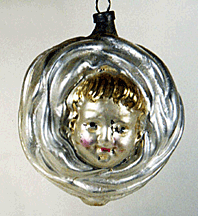 When
people look back over their lives, they often find that the memories and
emotions of Christmas rise above all the other emotions in both
vividness and intensity. Child-like emotions of excitement and
anticipation infect even adults during this time of year. Antique
Christmas ornaments can do more than anything to rekindle these
emotions. When
people look back over their lives, they often find that the memories and
emotions of Christmas rise above all the other emotions in both
vividness and intensity. Child-like emotions of excitement and
anticipation infect even adults during this time of year. Antique
Christmas ornaments can do more than anything to rekindle these
emotions.
At one time 95 percent of the glass tree
ornaments used on American Christmas trees came from the immediate
vicinity of Lauscha, near Nuremberg, Germany. Here, Louis Greiner-Schlotfeger
invented the glass Christmas ball. Glass making began here in the 1590's
when religious persecution forced groups of Protestant glass makers to
leave their homes in Bavaria and go east to the Thuringian mountains.
There they found an abundance of wood, sand, and limestone, the
necessary ingredients for their craft.
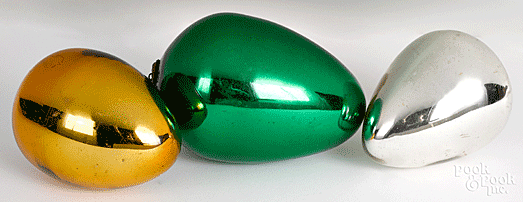
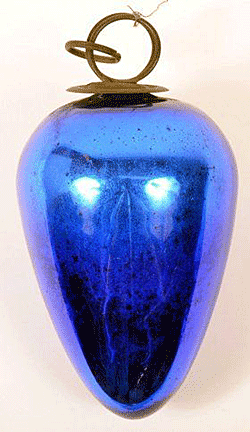 Soon Lauscha became a center for making
drinking glasses and bulls-eye window glass. By the middle of the 18th
century, Lauscha’s glassblowers had begun to make glass beads. Soon
the demands of the fashion industry made glass beads into the town’s
number-one business. Soon Lauscha became a center for making
drinking glasses and bulls-eye window glass. By the middle of the 18th
century, Lauscha’s glassblowers had begun to make glass beads. Soon
the demands of the fashion industry made glass beads into the town’s
number-one business.
But by 1845 glassblowers in Bohemia began to
produce superior beads. Overnight the village lost most of its bead
market to Bohemia. Fighting hard times, Louis Greiner-Schlotfeger began
blowing thick-walled glass balls known as kugels, which he
silvered with the Bohemian silver mirroring solution that he duplicated.
These were heavy, plainly colored pieces, shaped as balls and fruits.
Even though they appeared on every Christmas tree in Lauscha, the first
record of glass tree balls being produced didn't appear until 1848, when
"six dozen of Christmas tree ornaments in three sizes" was
recorded in a glassblower's ledger.
Early Ornaments
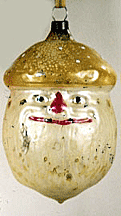 Among the oldest Christmas tree balls made in Lauscha were schecken,
meaning spotted or dappled–also known by the musical name of plumbum
(pronounced plumeboom), meaning lead. Among the oldest Christmas tree balls made in Lauscha were schecken,
meaning spotted or dappled–also known by the musical name of plumbum
(pronounced plumeboom), meaning lead.
While each ornament maker created his wares in
a small home workshop using his own designs, his wife took care of
silvering the inside of them. After she coated the insides, she would
hang them up to dry on long nails in rows from the ceiling over the
stove. The following morning she dipped the silver ornaments in various
colored lacquers and returned them to their nails to dry. Family members
helped paint trimmings, and the youngest child put on the little metal
caps. Working 8 to 15 hours a day, often 6 days a week, a family could
make from 300 to 600 ornaments a week.
In 1867, a gas works was built in the village
and for the first time, Greiner-Schlotfeger and the other glassblowers
had a steady, very hot, easily adjustable flame which allowed them to
make thin-walled bubbles of glass. Using this new heat source, Greiner-Schlotfeger
perfected a paper-thin, four-inch version of the old heavy kugel and in
1870, he discovered the idea for molded glass ornaments by blowing a
bubble of glass into a pine-cone-shaped cookie mold.
Fruits and Pine Cones
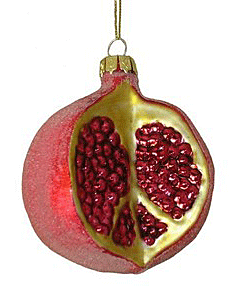 Soon the glassblowers began making tree ornaments in the shapes of pine
cones, apples, pears, and crystal icicles. In addition, they made
trumpets from twisted glass straws, handblown vases, birds, multicolored
acorns and elephants, ornate churches and dignified Saint Nicks. At
first they were only sold through rafftrageirs, or peddlers with
pack baskets, but in a short time, they were being exported to America. Soon the glassblowers began making tree ornaments in the shapes of pine
cones, apples, pears, and crystal icicles. In addition, they made
trumpets from twisted glass straws, handblown vases, birds, multicolored
acorns and elephants, ornate churches and dignified Saint Nicks. At
first they were only sold through rafftrageirs, or peddlers with
pack baskets, but in a short time, they were being exported to America.
By 1880, full-sized trees decorated with
expensive imported German glass ornaments became the rage with the
elite. American F. W. Woolworth reluctantly agreed to display a few
imported German glass ornaments to his Lancaster, Pennsylvania, store in
1880. To his amazement, his original $25 shipment sold out in two days.
By 1890, he was traveling to Germany to select his wares. Soon customers
added one or two of these special ornaments to their paper or fabric
tree decorations.
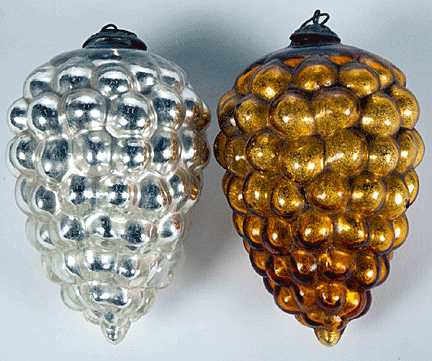
Ornaments From Molds
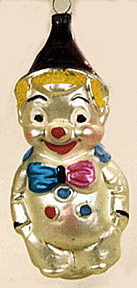 By 1890, the Lauscha glassblowers perfected the use of molds, called
formsachen, in their work. Though blowing an ornament in a mold
was a time-consuming but fairly simple operation, it paved the way for
mass production. Skilled craftsmen made the molds By 1890, the Lauscha glassblowers perfected the use of molds, called
formsachen, in their work. Though blowing an ornament in a mold
was a time-consuming but fairly simple operation, it paved the way for
mass production. Skilled craftsmen made the molds
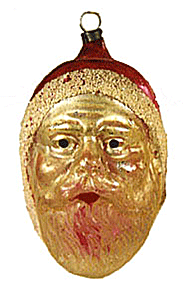 from wood or clay.
They designed
the object and then cast it in a plaster-of Paris-like material. With a
reusable mold, the glassblowers could reproduce an ornament many times
over. from wood or clay.
They designed
the object and then cast it in a plaster-of Paris-like material. With a
reusable mold, the glassblowers could reproduce an ornament many times
over.
Among the many
beautiful glass ornaments made from molds, Santa Claus figures, known to
the Lauscha glassblowers as Klausmaun, were a popular motif.
Sometimes just the head was shown. But when the entire figure was made,
whether wearing a long or short coat, the ornament always ended in a
rounded base with no legs. In the traditional manner, Santa frequently
carried a Christmas tree or bag of toys.
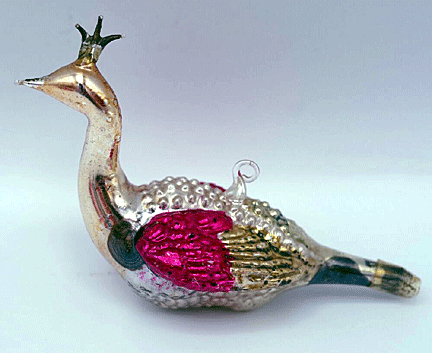 An enormous variety of ornaments―from over
5,000 different molds―came out of Lauscha between 1870 and 1940. Some
glassblowers blew by hand. But the ultimate design was a free-blown
eight-inch stork that stood majestically on a Christmas tree branch. An enormous variety of ornaments―from over
5,000 different molds―came out of Lauscha between 1870 and 1940. Some
glassblowers blew by hand. But the ultimate design was a free-blown
eight-inch stork that stood majestically on a Christmas tree branch.
Some of the glassblowers specialized in
free-blowing the "tree tops" shaped like the spike on a
Prussian officer's helmet. They also experimented with new ways to
decorate their creations and came up with etching the glass surface to
give their ornaments a frosted appearance.
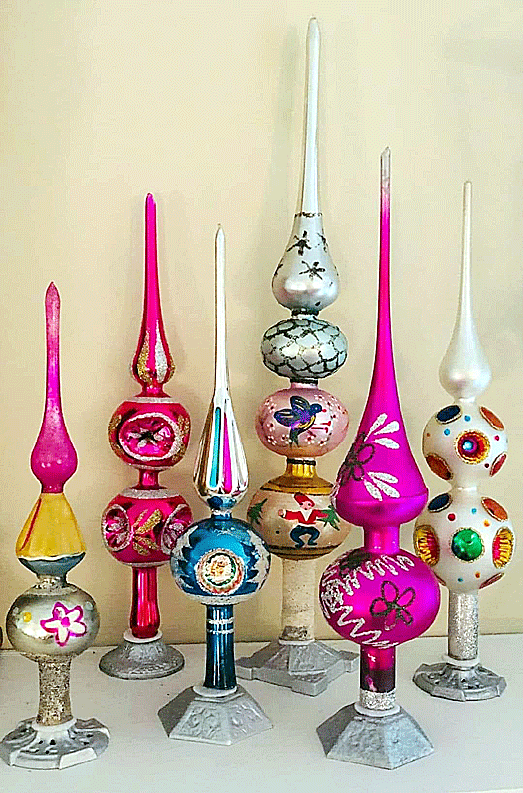
The War Took Its Toll
World War II ended Lauscha's fame as an ornament center in 1939.
After the war, the border placed the village ten miles inside East
Germany, but this didn't stop the glassblowers. Many fled to the West
and settled in Coburg.
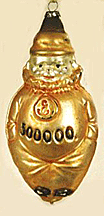 Soon the technical knowledge of making glass
ornaments spread to Bohemia (later part of Czechoslovakia) and Russia.
The glassmakers of Bohemia, long known for their sparkling red glass,
adopted bead making to strings of beads for Christmas trees. They began
making ornaments by the end of the 19th century and soon
competed head on with the Germans. Soon the technical knowledge of making glass
ornaments spread to Bohemia (later part of Czechoslovakia) and Russia.
The glassmakers of Bohemia, long known for their sparkling red glass,
adopted bead making to strings of beads for Christmas trees. They began
making ornaments by the end of the 19th century and soon
competed head on with the Germans.
The celebration of Christmas had always been
big in Russia until the Communists came into power after the revolution
in 1917. They made Christmas into an atheistic holiday and banned
Christmas trees. However, in the early 1920's, Lenin, realizing that his
badly floundering economy was about to go under, permitted some private
enterprise. One of the first cottage industries to emerge featured hand
blown, hand painted glass Christmas ornaments picturing fanciful images
of Grandfather Frost, the Snow Maiden and other
popular Russian folk tale figures. Glassblowers created individually
handblown ornaments from the early 1920s to the 1960s.. Even those of
the same kind were silvered and painted entirely by hand by different
artists.
What to Look For
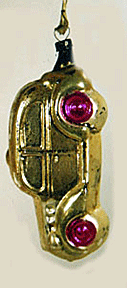 Within the past 15 years, collecting old glass ornaments has become
trendy,
creating a thriving market for these beautiful glass creations. It's
difficult to tell which of the old glass ornaments came from Germany,
as many were also made in Czechoslovakia and Russia, and few makers
signed them. Within the past 15 years, collecting old glass ornaments has become
trendy,
creating a thriving market for these beautiful glass creations. It's
difficult to tell which of the old glass ornaments came from Germany,
as many were also made in Czechoslovakia and Russia, and few makers
signed them.
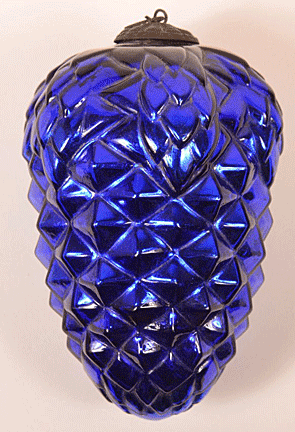 The pine cone was, by far, the most popular
design. Other favorites were Santas, birds, nuts, flowers, clusters of
grapes, and musical instruments such as drums and violins. Glassblowers
experimented with geometric designs, too, most of them intricate and
ingenious variations on the basic ball shape. The pine cone was, by far, the most popular
design. Other favorites were Santas, birds, nuts, flowers, clusters of
grapes, and musical instruments such as drums and violins. Glassblowers
experimented with geometric designs, too, most of them intricate and
ingenious variations on the basic ball shape.
It was typical to make a single design, such as
an acorn or a tulip, in three different sizes, all exact replicas. Only
a large collection of old ornaments can reflect the seemingly endless
number of molds made between the 1880s and 1940. Manufacturers offered
new designs each season to stimulate business and many of the rarest of
them today most likely were produced for a single season by a single
man.
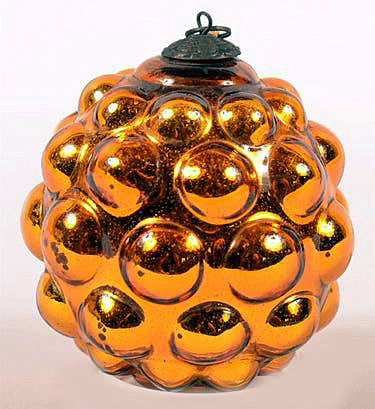 Today, there's been a resurgence of interest in
the old designs and many reproductions are available. Tim and Beth Merck
of Spokane, Washington, founded Merck Family's Old World Christmas in
1979. This couple shares a special love for Christmas, especially its
rich traditions in the European style. Today, the Merck Family's Old
World Christmas is the leading distributor of quality glass ornaments in
the U.S. Each glass ornament produced for the Merck Family's Old World
Christmas is hand crafted in age-old traditions. Molten glass is
mouth-blown into finely created molds, which are available only to the
company, before being hand-painted and finished. Each ornament is
authentically created with the same techniques originated in the 1800's,
thus making it difficult to tell them from the originals. Today, there's been a resurgence of interest in
the old designs and many reproductions are available. Tim and Beth Merck
of Spokane, Washington, founded Merck Family's Old World Christmas in
1979. This couple shares a special love for Christmas, especially its
rich traditions in the European style. Today, the Merck Family's Old
World Christmas is the leading distributor of quality glass ornaments in
the U.S. Each glass ornament produced for the Merck Family's Old World
Christmas is hand crafted in age-old traditions. Molten glass is
mouth-blown into finely created molds, which are available only to the
company, before being hand-painted and finished. Each ornament is
authentically created with the same techniques originated in the 1800's,
thus making it difficult to tell them from the originals.
The Ornament Market
 While Christmas shops, like the one in Manteo, North Carolina, overflow
with newer renditions, it's flea markets and yard sales in late summer
and early fall that hold the real finds. Sometimes, they're sold
individually for 25 cents and up or in a box lot for $2 or $3. It takes
some ingenuity and imagination, but from time to time a valuable
ornament does surface. While Christmas shops, like the one in Manteo, North Carolina, overflow
with newer renditions, it's flea markets and yard sales in late summer
and early fall that hold the real finds. Sometimes, they're sold
individually for 25 cents and up or in a box lot for $2 or $3. It takes
some ingenuity and imagination, but from time to time a valuable
ornament does surface.
The market is strong. Old glass ornaments sell from $10 to $500-600
each. Tthe ornament's age, color,
condition and manufacturer determines the price. Unfortunately, the detail of the painting is
often flaking off and mint pieces are becoming harder to find. But when
a collector does find one, it can make it seem like Christmas no matter
what day of the year it is.
Collectors can stay in touch and learn more
about antique ornaments through organizations such as the Golden Glow of
Christmas Past, a national club for people who collect antique Christmas
decorations. Another popular group is COOL (Collecting Ornaments
On-Line) Collectors Club, a virtual collectors' club. Groups like these
are an invaluable aid to the novice collector.
<
Back to Collectibles Archives
Next Article > |
